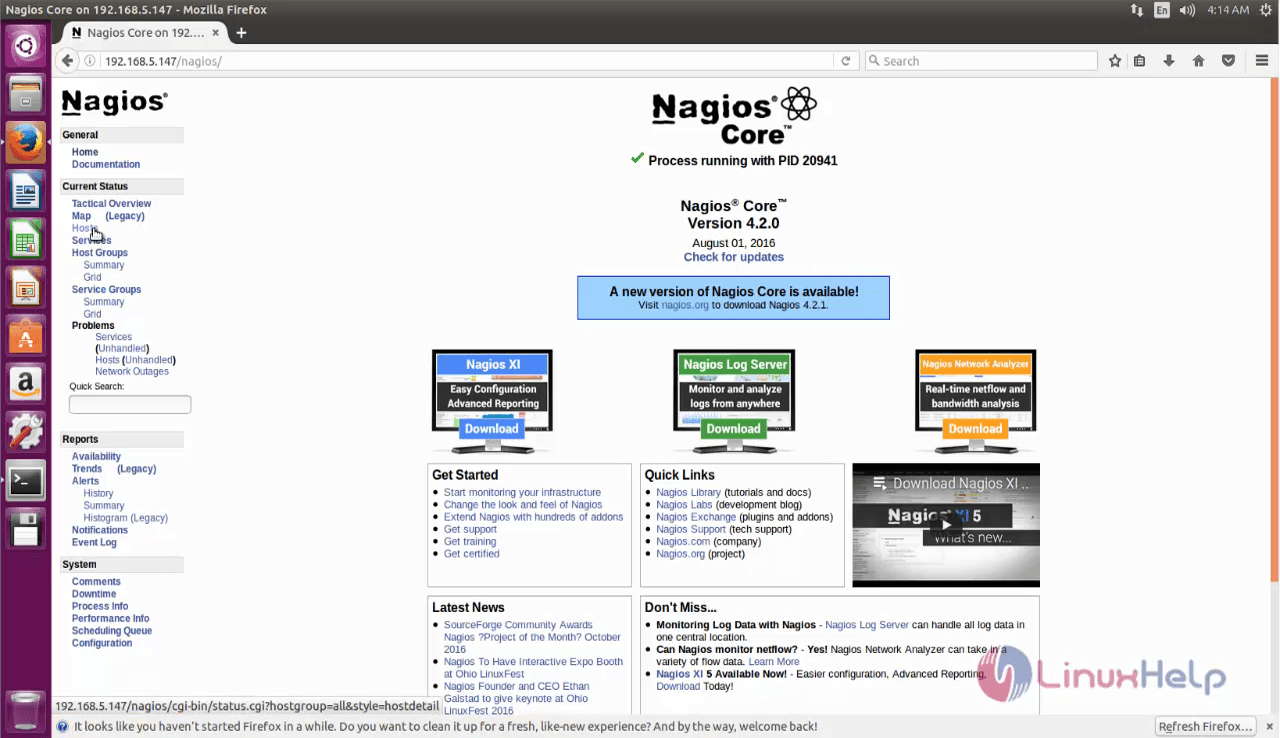How to add Host into Nagios Server
To add Host into Nagios Server
In this article we will learn the procedures to add Host into Nagios server.
Nagios Server IP - 192.168.5.147 Nagils Host IP - 192.168.5.146
To install NRPE Services and Nasgios Plugins
Utilize the below command to install the NRPE Service and nagios plugins on Host machine.
root@linuxhelp:~# apt-get install nagios-nrpe-server nagios-plugins -y
Reading package lists... Done
Building dependency tree
Reading state information... Done
The following packages were automatically installed and are no longer required:
libntdb1 python-ntdb
Use ' apt-get autoremove' to remove them.
The following extra packages will be installed:
libdbi1 libldb1 libmysqlclient18 libnet-snmp-perl libpq5 libsmbclient libtirpc1 libwbclient0 mysql-common nagios-plugins-basic nagios-plugins-common
nagios-plugins-standard python-ldb python-samba rpcbind samba-common samba-common-bin samba-libs smbclient snmp whois
.
.
.
Selecting previously unselected package nagios-plugins-common.
Preparing to unpack .../nagios-plugins-common_1.5-3ubuntu1_amd64.deb ...
Unpacking nagios-plugins-common (1.5-3ubuntu1) ...
Processing triggers for man-db (2.7.4-1) ...
Processing triggers for ureadahead (0.100.0-19) ...
Processing triggers for systemd (225-1ubuntu9) ...
Errors were encountered while processing:
/var/cache/apt/archives/mysql-common_5.6.31-0ubuntu0.15.10.1_all.deb
E: Sub-process /usr/bin/dpkg returned an error code (1)
After installing the dependencies, Open and add the Nagios server IP address into the configuration file.
root@linuxhelp:~# vim /etc/nagios/nrpe.cfg
server_address=192.168.5.147
Then restart NRPE services to make the changes active.
root@linuxhelp:~# service nagios-nrpe-server restart
Make sure that the above change is applied on the host machine.
To configure Nagios server
After configuring the host, login to Nagios Server and do the following steps.
Create new configuration file for host that is to be added into Nagios.
root@linuxhelp:~# vim /usr/local/nagios/etc/servers/host.cfg
Add the following entry in to the newly created file.
# Ubuntu Host configuration file
define host {
use linux-server
host_name linuxhelp
alias Ubuntu Host
address 192.168.1.10
register 1
}
define service {
host_name linuxhelp
service_description PING
check_command check_ping!100.0,20%!500.0,60%
max_check_attempts 2
check_interval 2
retry_interval 2
check_period 24x7
check_freshness 1
contact_groups admins
notification_interval 2
notification_period 24x7
notifications_enabled 1
register 1
}
define service {
host_name linuxhelp
service_description Check Users
check_command check_local_users!20!50
max_check_attempts 2
check_interval 2
retry_interval 2
check_period 24x7
check_freshness 1
contact_groups admins
notification_interval 2
notification_period 24x7
notifications_enabled 1
register 1
}
define service {
host_name linuxhelp
service_description Local Disk
check_command check_local_disk!20%!10%!/
max_check_attempts 2
check_interval 2
retry_interval 2
check_period 24x7
check_freshness 1
contact_groups admins
notification_interval 2
notification_period 24x7
notifications_enabled 1
register 1
}
define service {
host_name linuxhelp
service_description Check SSH
check_command check_ssh
max_check_attempts 2
check_interval 2
retry_interval 2
check_period 24x7
check_freshness 1
contact_groups admins
notification_interval 2
notification_period 24x7
notifications_enabled 1
register 1
}
define service {
host_name linuxhelp
service_description Total Process
check_command check_local_procs!250!400!RSZDT
max_check_attempts 2
check_interval 2
retry_interval 2
check_period 24x7
check_freshness 1
contact_groups admins
notification_interval 2
notification_period 24x7
notifications_enabled 1
register 1
}
After adding the entry, test Nagios configuration
root@linuxhelp:~# /usr/local/nagios/bin/nagios -v /usr/local/nagios/etc/nagios.cfg
Nagios Core 4.2.0
Copyright (c) 2009-present Nagios Core Development Team and Community Contributors
Copyright (c) 1999-2009 Ethan Galstad
Last Modified: 08-01-2016
License: GPL
Website: https://www.nagios.org
Reading configuration data...
Read main config file okay...
Read object config files okay...
Running pre-flight check on configuration data...
Checking objects...
Checked 13 services.
Checked 2 hosts.
Checked 1 host groups.
Checked 0 service groups.
Checked 1 contacts.
Checked 1 contact groups.
Checked 24 commands.
Checked 5 time periods.
Checked 0 host escalations.
Checked 0 service escalations.
Checking for circular paths...
Checked 2 hosts
Checked 0 service dependencies
Checked 0 host dependencies
Checked 5 timeperiods
Checking global event handlers...
Checking obsessive compulsive processor commands...
Checking misc settings...
Total Warnings: 0
Total Errors: 0
Things look okay - No serious problems were detected during the pre-flight check
Then restart the services.
root@linuxhelp:~# service nagios-nrpe-server restart
root@linuxhelp:~# service apache2 restart
root@linuxhelp:~# service nagios restart
Access the browser and click hosts to view the status of the hosts that is appended to the Nagios


Comments ( 1 )